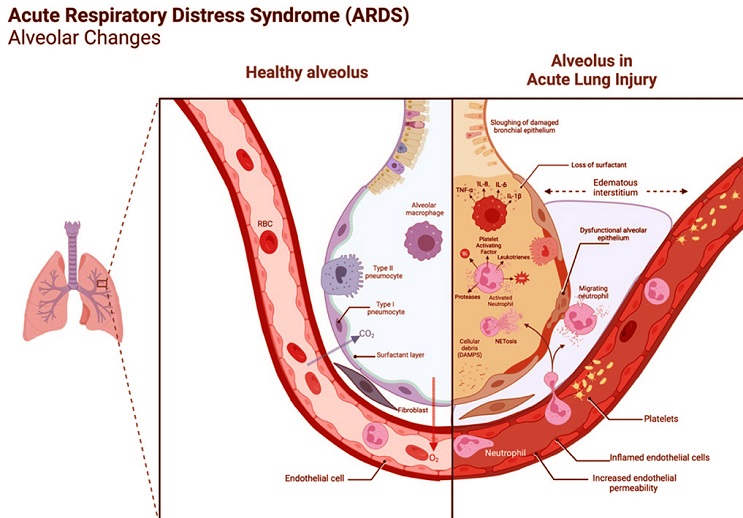Nikhil Prasad Fact checked by:Thailand Medical News Team Nov 30, 2024 1 year, 2 weeks, 19 hours, 37 minutes ago
Medical News: A recent study, conducted by researchers from Dalhousie University in Canada, delves into the unique and familiar mechanisms of lung damage caused by COVID-19. Acute lung injury (ALI), commonly diagnosed as acute respiratory distress syndrome (ARDS), is a severe condition involving inflammation, fluid buildup, and difficulty in oxygen exchange within the lungs. With the emergence of COVID-19, understanding the differences between traditional lung injuries and those caused by the SARS-CoV-2 virus has become critical for developing targeted treatments.
 Canadian Study Unveils the Uniqueness of COVID-19 Induced Acute Lung Injury
Alveolar changes during ALI. Under normal conditions (left), gas exchange is facilitated by a thin epithelial - endothelial barrier which is maintained by the collective functions of alveolar epithelial cells (pneumocytes), endothelial cells, and alveolar macrophages. During ALI (right), damage to the epithelial–endothelial barrier sets in motion a cascade of inflammatory processes that exacerbate tissue damage, accelerate edema formation, and critically impair gas exchange.
Exploring Acute Lung Injury
Canadian Study Unveils the Uniqueness of COVID-19 Induced Acute Lung Injury
Alveolar changes during ALI. Under normal conditions (left), gas exchange is facilitated by a thin epithelial - endothelial barrier which is maintained by the collective functions of alveolar epithelial cells (pneumocytes), endothelial cells, and alveolar macrophages. During ALI (right), damage to the epithelial–endothelial barrier sets in motion a cascade of inflammatory processes that exacerbate tissue damage, accelerate edema formation, and critically impair gas exchange.
Exploring Acute Lung Injury
ALI is not new. It has been associated with conditions like pneumonia, sepsis, and physical trauma. The Berlin definition classifies ARDS into mild, moderate, and severe based on oxygen levels in the blood and other clinical markers. Despite advancements in medical care, mortality rates for ARDS remain between 34.9% and 46.1%, depending on severity.
COVID-19, however, introduced new challenges. The sheer number of cases and the unique ways the virus interacts with the immune and respiratory systems have led to unprecedented demands on healthcare systems globally. In 2020 alone, COVID-19-related ARDS caused a significant surge in deaths worldwide. This
Medical News report unpacks the insights shared by the Dalhousie researchers on what makes COVID-19 lung injury distinct.
Unique Features of COVID-19 Lung Injury
The study identifies several key differences between COVID-19-induced lung damage and other causes of ALI:
-Suppression of Interferon Responses: COVID-19 disrupts the body’s ability to mount an early antiviral defense by suppressing interferons, critical proteins in the immune response.
-Inflammasome Activation: The SARS-CoV-2 virus triggers widespread activation of inflammasomes, molecular complexes that amplify inflammation. This process leads to severe tissue damage and immune dysregulation.
-Altered Immune Cells: Leukocytes (white blood cells) behave differently in COVID-19, showing both hyperactivity and functional impairments. This creates an imbalance in the immune system’s ability to fight the virus and repair tissue.
-Thrombotic Activity: COVID-19 leads to abnormal blood clot for
mation, contributing to complications like microthrombosis in lung capillaries, which exacerbates oxygen exchange issues.
These mechanisms interact in ways that make COVID-19 lung injury more complex than other forms of ARDS, such as those caused by bacterial pneumonia or non-pulmonary sepsis.
The Path to Severe COVID-19
COVID-19’s progression often begins with mild symptoms like fever and cough but can escalate rapidly in certain individuals. In severe cases, patients develop ARDS, septic shock, and multiple organ failures. The study highlights risk factors such as older age, pre-existing conditions like diabetes and hypertension, and male sex.
The virus primarily targets cells in the respiratory tract using the ACE2 receptor. Once inside, SARS-CoV-2 disrupts cellular machinery to replicate and spread. The immune system’s response to this invasion often spirals out of control, resulting in both direct tissue damage and harmful inflammatory cascades.
Differences from Other Lung Injury Causes
The researchers compare COVID-19 lung injury with injuries caused by:
-Other Viruses: While SARS-CoV-1 and MERS-CoV share similarities with SARS-CoV-2, including immune suppression and inflammatory responses, the extent of microvascular dysfunction is more pronounced in COVID-19. Influenza, another respiratory virus, shows distinct patterns, with less widespread microthrombi but significant localized inflammation.
-Bacterial Pneumonia: COVID-19 differs in its impact on the vascular endothelium. While bacterial pneumonias often involve neutrophilic responses, COVID-19 is marked by monocyte-derived macrophages and lymphocytic infiltration.
-Non-Pulmonary Sepsis: Both conditions share immune dysregulation and coagulopathy, but COVID-19’s impact on the lung vasculature is more severe.
Implications for Treatment
Understanding these distinctions is essential for tailoring therapies. For instance, strategies that work for bacterial or viral pneumonias may not be as effective for COVID-19. Anti-inflammatory treatments, anticoagulants, and targeted therapies addressing immune dysregulation are potential areas of focus.
Conclusion
The study emphasizes that COVID-19 lung injury involves a unique interplay of viral and host factors. The suppression of early immune responses allows the virus to replicate unchecked, while subsequent hyperactivation of inflammatory pathways leads to extensive damage. Microvascular dysfunction and abnormal clotting further complicate recovery. These insights underline the importance of continued research into targeted therapies and personalized medicine for COVID-19 patients.
The findings of this research were published in the peer-reviewed journal: Applied Sciences.
https://www.mdpi.com/2076-3417/14/23/11048
For the latest COVID-19 News, keep on logging to Thailand
Medical News.
Read Also:
https://www.thailandmedical.news/news/covid-19-linked-to-dangerous-lung-scarring-through-mast-cell-activation
https://www.thailandmedical.news/news/lung-ultrasound-proves-effective-in-identifying-long-term-post-covid-19-lung-damage
https://www.thailandmedical.news/news/covid-19-is-not-mild-as-most-will-develop-lung-fibrosis-10-percent-of-all-lung-transplants-in-u-s-now-go-to-post-covid-patients
